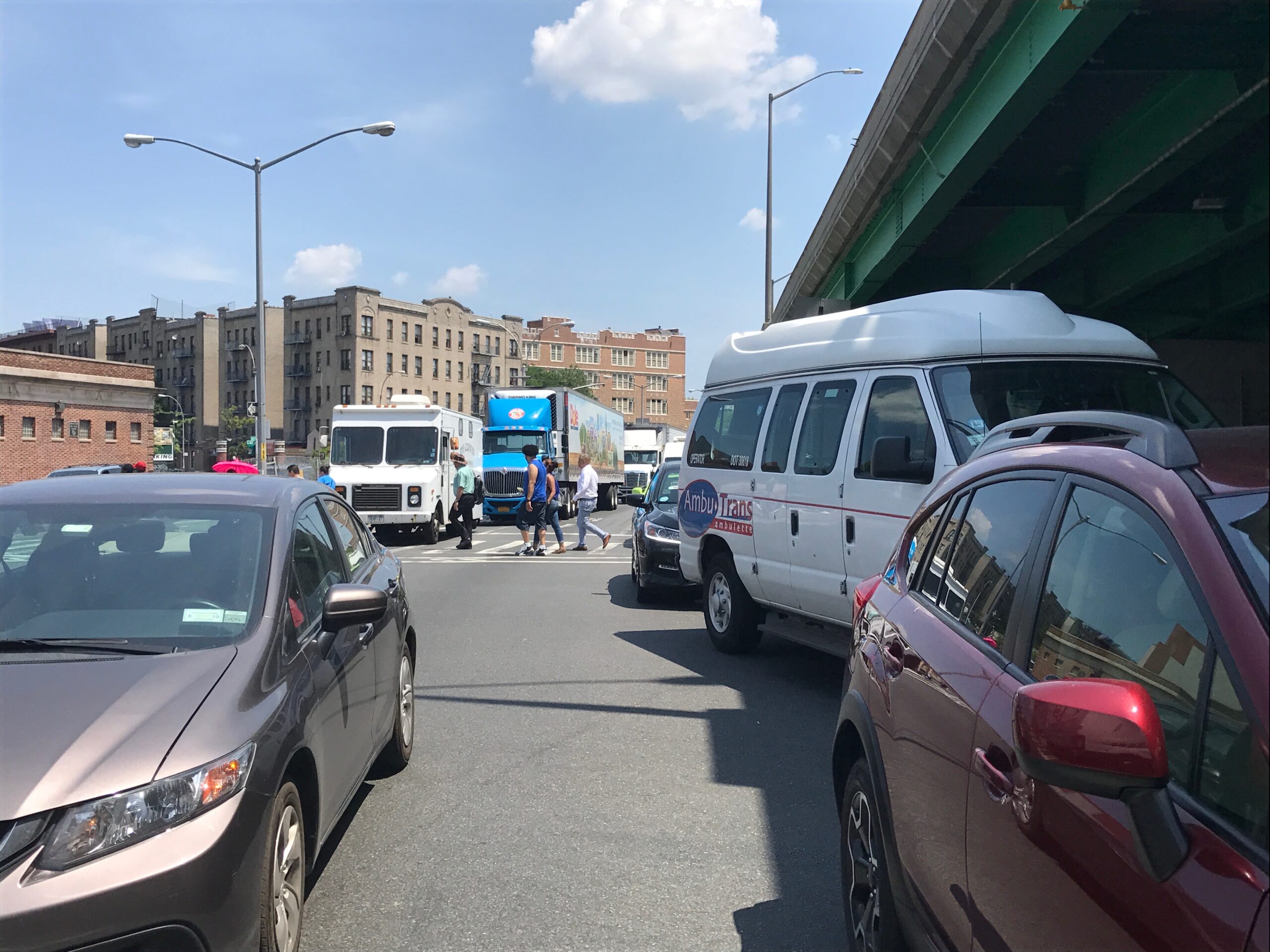When Gov. Kathy Hochul put an indefinite pause in June on much-anticipated plans for congestion pricing in the city, under pressure not to burden suburban commuters with steep tolls, some responded with relief, others with anger.
Congestion pricing has drawn mixed reactions from South Bronx advocates, who recognize its importance for financing the city’s public transit system but worry it will increase air pollution in low-income neighborhoods like Hunts Point and Mott Haven, which are plagued with some of the city’s foulest air.
That dichotomy is not new. From construction of the Cross Bronx Expressway in the 1950s to the city’s 2011 decision to bring FreshDirect and its trucking fleet to Port Morris, residents have railed against transportation policies that compromise further foul the Bronx air while serving customers in Manhattan.
During an environmental stewardship event at Concrete Plant Park in July, The Point CDC’s director of community development, Dariella Rodriguez, said there is concern that drivers headed south into Manhattan will stop and park in Hunts Point, piling on to emissions from the trucking fleets at the food distribution market.
“Ten years ago, we were 100 percent for congestion pricing,” said Rodriguez. “That was before the collapse of the infrastructure in transportation and roads, devastation from extreme weather like flooding, and the pandemic. Now, in the news and from people’s own experiences, they know that air quality and effective transportation have both deteriorated.”
In a 2021 report, The New York City Environmental Justice Alliance found that particulate matter levels were among the city’s highest near the food distribution center, where an estimated 15,000 truck trips take place every day.
Rodriguez, who was at the Concrete Plant Park event in July to inform the public about a city plan to reroute trucks, said residents she spoke with there had different ideas to reduce air pollution, including putting fees on diesel trucks.
Henry Jorden, an environmental steward for The Bronx is Blooming, said charging drivers as a way to cut down on pollution is an “interesting and exciting idea but that “The Bronx is going to bear the brunt of traffic that’s congested further uptown. Our organization officially doesn’t take a stance at this particular point, but we do know firsthand how much respiratory illnesses are increased in areas around the Cross Bronx Expressway, the Bruckner, all of the highway systems that choke our borough.”
Still, a mentor with that organization, Gaia Rueda, said “Losing congestion pricing is going to mean that there’s more stress put on the environment. Because stress that air pollution creates on us is also stress for trees and other wildlife.”
The Chair of Community Board One’s environmental committee, Cesar Yoc, said that despite the benefits, congestion pricing has the potential to do more harm than good locally.
“[It’s] complicated, but, like water, traffic needs to go somewhere,” said Yoc. “Unless there is reduction of trucks and cars at the same time this is happening, it will create [traffic] in neighborhoods outside Manhattan.”
Some, such as Mott Haven resident Alexander Schwarz, say the benefits outweigh the negatives, by creating “better transit, cleaner air, safer streets and stronger economy.”
Representatives from the grassroots group South Bronx Unite are similarly divided.
Arif Ullah, the group’s executive director, acknowledged at a Baruch College annual meeting on Ethics in April that although he is for the policy, “even adding a few more trucks to our roadways is harmful to our community.”
Leslie Vasquez, South Bronx Unite’s Clean Air Project organizer, said mitigating the harmful impacts of air pollution by monitoring air quality to push for policy change is key. She has advocated against congestion pricing.
South Bronx Unite has collaborated with the Columbia Mailman School of Public Health to install 65 air quality monitors across the neighborhood, with funding from the health department.
“We have a few monitors located by the bridges, where congestion pricing would reroute traffic from lower Manhattan up to the South Bronx,” said Vasquez. Monitoring at those locations, she said, would help establish air quality baselines before and during congestion pricing when it is implemented.
“Having more green spaces, having more health centers, distributing more asthma pumps, anything that will help us mitigate the issue,” she said.
When Gov. Hochul announced the pause on implementation, City Councilwoman Diana Ayala issued a statement agreeing. Ayala, whose district includes Mott Haven and Port Morris, said the city’s economic post-pandemic hangover is still fresh.
“Our post Covid recovery is still too fragile to be disrupted, and a pause is the right way to go. We’ve waited this long, a bit longer won’t hurt,” Ayala Tweeted.
Assemblywoman Amanda Septimo told the Express she doesn’t share the advocates’ concern that drivers will use the South Bronx as a pitstop, and considers congestion pricing a net benefit for the neighborhoods.
“The notion that we have all of the space to absorb all of these additional drivers who want to park and then ride just doesn’t feel grounded in reality,” said Septimo, whose district includes Mott Haven and Longwood.
“But let’s assume that that’s something that people decide to do and that we suddenly have the space for,” she added. “One of the things that many people talk about, and I know that there’s legislation on the state level for now to explore, is the concept of residential parking permits.”
Addressing the disproportionate impact of pollution in low-income communities appears to be a priority on Kamala Harris’ environmental agenda in her run for the presidency. But locally, Leslie Vasquez said the city is once again failing to take community voices into account.
“If we were to create a congestion pricing proposal, we would definitely include the community first, which is not something that the MTA did,” she said. “Traffic doesn’t disappear with congestion pricing. For all of the seven scenarios that the MTA proposed, it will go into the South Bronx.”

